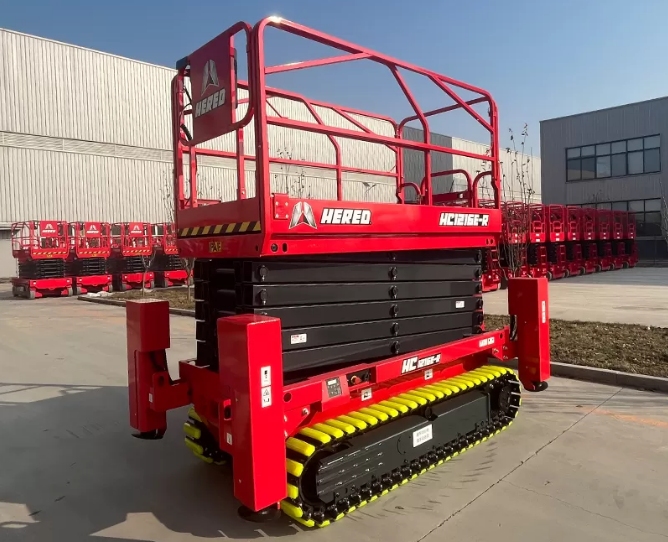Ultimate Guide to Aerial Work Platforms (AWPs)
Aerial work platforms (AWPs) play a crucial role in numerous industries, providing a safer and more efficient alternative to ladders and scaffolding for tasks at elevated heights. Whether in warehousing, building maintenance, farming, or construction, AWPs enable workers to perform their jobs effectively and securely. This guide offers a comprehensive look at AWPs, including mobile elevated work platforms (MEWPs) and aerial lifts, highlighting their types, uses, and significance in facilitating safe operations.
What is an Aerial Work Platform?
An aerial work platform (AWP), also called an aerial lift, elevating work platform (EWP), cherry picker, bucket truck, or mobile elevating work platform (MEWP), is a mechanical device designed to provide temporary access to otherwise unreachable areas, typically at height. These platforms are engineered to lift limited weights, generally under one ton, and are often operated by a single individual. Common applications include maintenance, construction, warehouse operations, and any tasks requiring flexible, temporary access to elevated spaces.
Types of Aerial Work Platforms
Platform lift for sale comes in several types, each tailored to specific tasks. Choosing the right AWP depends on factors like indoor or outdoor use, required working height, and the project's unique demands. Below is an overview of the main AWP types, along with their advantages and limitations:
1. Boom Lifts
Feature: Hydraulic arm with a bucket at the end for vertical and horizontal reach.
- Pros: Excellent for reaching high areas, suitable for rough terrain, some models offer 360-degree rotation.
- Cons: Limited outreach compared to other AWPs; restricted access in tight spaces.
2. Articulating Boom Lifts
Feature: Multiple articulating sections for enhanced flexibility in accessing challenging areas.
- Pros: Ideal for reaching difficult spots due to articulated sections.
- Cons: Less horizontal reach than telescopic boom lifts; limited use in tight spaces.
3. Telescopic Boom Lifts
Feature: Straight arm that extends telescopically for outstanding horizontal reach.
- Pros: Exceptional horizontal reach, great for areas with limited access.
- Cons: Less flexibility compared to articulating boom lifts; limited use in confined spaces.
4. Scissor Lifts
Feature: Folding mechanism for straight vertical movement.
- Pros: Perfect for vertical lifting, large platform space for equipment on some models.
- Cons: Cannot reach over obstacles; limited outreach.
5. Vertical Mast Lifts
Feature: Compact, maneuverable design for vertical access in tight spaces.
- Pros: Compact and suitable for indoor use and confined areas.
- Cons: Limited to vertical access; unsuitable for overcoming obstacles.
6. Towable Lifts
Feature: Portable and towable behind vehicles for easy transportation.
- Pros: Highly portable, flexible transportation options.
- Cons: Restricted height and weight capacity; requires a towing vehicle.
7. Personnel Lifts
Feature: Electric-powered lifts designed for tight or confined indoor spaces.
- Pros: Efficient for indoor use, compact design for confined areas.
- Cons: Limited height and weight capacity; not suitable for rough outdoor terrain.
What are MEWPs?
Mobile Elevated Work Platforms (MEWPs), previously referred to as Aerial Work Platforms (AWPs), received their updated terminology from the American National Standards Institute (ANSI). MEWPs are powered equipment designed to provide safe access to elevated work areas and are classified based on two factors: group and type.
- Group Classification
- Group A: The platform moves vertically while remaining within the tipping lines.
- Group B: The platform extends beyond the tipping lines during operation.
- Type Classification
- Type 1: Can only move when the platform is in the stowed position.
- Type 2: Equipped with additional movement features when the platform is in use.
- Type 3: Capable of traveling with the platform elevated, controlled from within the work platform.
This classification system helps ensure the appropriate equipment is selected for various tasks, enhancing safety and efficiency.
Types of MEWPs
MEWPs come in various types, with each designed for specific tasks. Proper selection depends on the requirements of the job. MEWPs are classified by their movement capabilities and control mechanisms, which influence their suitability for different applications.
- Type 1 MEWPs
- Movement: Operable only when the platform is in the stowed position.
- Examples: Vertical lifts and scissor lifts.
- Applications: Ideal for tasks requiring stable, vertical access within tipping lines, such as maintenance and construction work.
- Type 2 MEWPs
- Movement: Can travel with the platform elevated but controlled from the chassis area.
- Examples: Certain boom lifts.
- Applications: Suitable for jobs needing elevated access with controlled movement, such as maintenance and installation tasks.
- Type 3 MEWPs
- Movement: Capable of traveling with the platform elevated and controlled from within the work platform.
- Examples: Self-propelled articulating and telescopic booms.
- Applications: Used for tasks requiring both height and maneuverability, including construction, electrical repair, and firefighting.
AWPs vs MEWPs
The principal difference between AWPs and MEWPs is terminology and classification. Previously, the term AWP was used to refer to various elevated work platforms such as scissor lifts and boom lifts. However, the new term MEWP, has been introduced to encompass a broader range of equipment. MEWPs are now categorized based on group and type, whereas AWPs were identified by the name of the aerial lift. For example, scissor lifts and boom lifts, are not only AWPs, but specific types of MEWPs, and the term MEWP is now used as the more comprehensive and standardized term for this category of aerial lift equipment.
Industries Using Various Types of AWPs and MEWPs
AWPs and MEWPs have become indispensable across many industries due to their ability to provide safe and efficient access to elevated areas. By reducing on-the-ground costs and boosting productivity, these machines quickly justify their investment. Below are key industries that rely on them daily:
- Construction Sites
- Ideal for precise and detailed work at heights.
- Support workers and tools for extended periods, enabling focus and efficiency.
- Telecommunications
- Enhance speed and safety during maintenance of telecommunication assets.
- Allow workers to access lines closely while safely transporting necessary tools.
- General Building Maintenance
- Eliminate the need for workers to carry heavy tools manually.
- Support both personnel and equipment, streamlining tasks like window cleaning or repairs.
- Warehousing
- Facilitate inventory evaluation and retrieval from high shelves.
- Improve inventory management, processing speed, and employee safety.
- Agriculture
- Assist with harvesting crops from tall trees or maintaining tree foliage.
- Safely store equipment during use, reducing risks of accidents from falling objects.
AWPs and MEWPs are vital tools for industries requiring safe, high-access solutions. Selecting the right equipment ensures efficiency and safety for any task.





